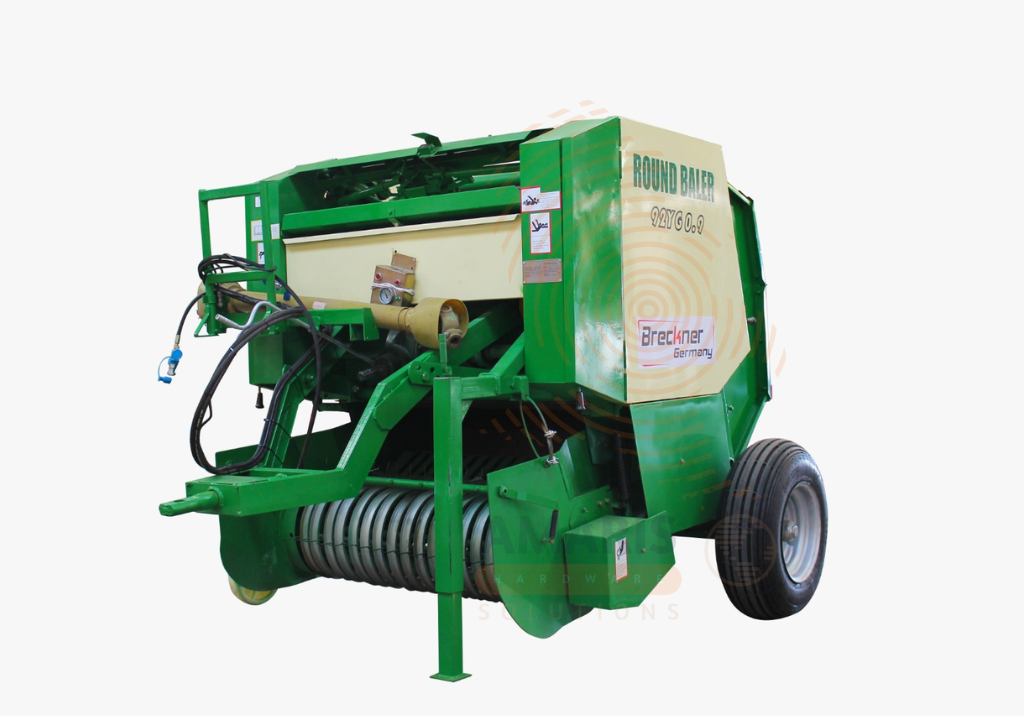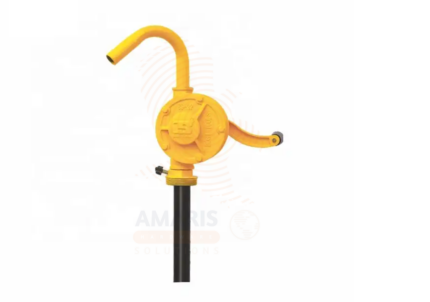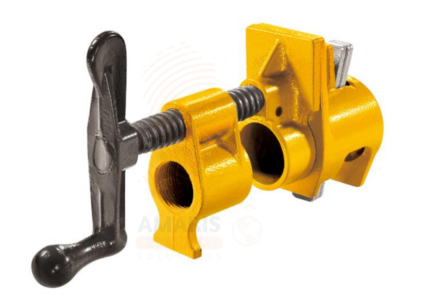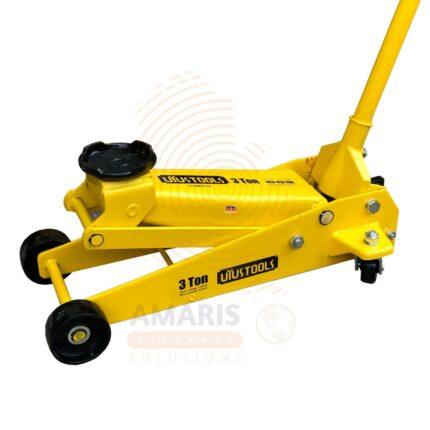Hay Baler
WhatsApp Order
A Hay Baler is an agricultural machine designed to compress cut and raked crops such as hay, straw, or silage into compact bales that are easy to handle, transport, and store. Hay balers come in various types, including round balers, square balers, and large rectangular balers, each producing bales of different shapes and sizes to suit specific storage and feeding needs. The baling process preserves the nutritional quality of forage and helps farmers efficiently manage fodder for livestock. Hay balers are essential equipment in modern farming, improving productivity and reducing labor.
Description
Table of Contents
ToggleHay Baler Uses
-
Forage Collection and Storage
o Compresses hay, straw, or silage into bales for efficient storage and protection against weather.
o Helps maintain the nutritional value of animal feed during storage. -
Livestock Feeding
o Produces manageable-sized bales that can be easily transported and fed to livestock.
o Enables rationing of feed over time. -
Field Cleanup
o Gathers leftover crop residues to clear fields for subsequent planting or harvesting.
o Helps reduce fire hazards by collecting dry plant material. -
Transport and Handling
o Creates compact bales that optimize space in transport vehicles and storage areas.
o Facilitates mechanical handling with loaders or bale wagons. -
Straw and Biomass Collection
o Bales straw and other biomass for use in animal bedding, mulch, or bioenergy production. -
Erosion Control and Landscaping
o Baled straw can be used in erosion control projects and landscaping applications.
SAFETY HANDLING PRECAUTIONS
Safety Precautions
-
Use Proper Personal Protective Equipment (PPE)
o Wear gloves to protect hands from sharp edges and pinch points.
o Use safety boots to protect feet from heavy bales and machinery. -
Machine Inspection
o Check for worn or damaged belts, chains, and hydraulic components before use.
o Ensure all safety shields and guards are intact and properly secured. -
Safe Operation
o Operate the baler only when all personnel are clear of moving parts.
o Avoid wearing loose clothing that can get caught in machinery.
o Maintain proper speed and follow manufacturer’s operating instructions. -
Handling Bales
o Use appropriate machinery or tools to lift and move bales to avoid injury.
o Be cautious of bale weight and stability during stacking. -
Prevent Fires
o Keep the baler clean from debris buildup, which can be a fire hazard.
o Monitor for overheating components during operation. -
Emergency Preparedness
o Know emergency shutdown procedures.
o Keep a fire extinguisher nearby during operation. -
Training and Supervision
o Only trained and authorized personnel should operate the hay baler.
o Follow all safety and maintenance guidelines as per manufacturer’s manual. -
Safe Maintenance
o Disconnect power and relieve hydraulic pressure before servicing.
o Regularly lubricate and maintain components to prevent failures.
Related products
Direct Drive Air Compressor
A direct drive air compressor is a type of air compressor where the motor is directly connected to the compressor pump, typically without the use of belts or gears. In this configuration, the motor and the pump share a common shaft, resulting in a more compact and efficient design. Direct drive compressors are known for their simplicity, reduced maintenance requirements, and higher power transmission efficiency compared to belt-driven or gear-driven counterparts. They are commonly used in various applications, including powering pneumatic tools, inflating tires, and providing compressed air for industrial processes.
Feed Mixer
PRODUCT DESCRIPTION
A feed mixer is an agricultural machine designed to blend various ingredients—such as grains, vitamins, minerals, and additives—into a uniform feed mixture for livestock and poultry. These mixers come in different forms, including horizontal, vertical, and paddle mixers, and are essential in both small-scale farms and large commercial feed operations. Feed mixers ensure consistent nutrient distribution, improve feed efficiency, and reduce feed waste. By automating the mixing process, they also save time and labor while enhancing the health and productivity of animals through balanced rations.
Floor Jack
PRODUCT DESCRIPTION
A floor jack is a mechanical device used to lift heavy vehicles, such as cars or trucks, off the ground to facilitate maintenance or repairs. It typically consists of a horizontal hydraulic cylinder, a handle for pumping, and a lifting pad that comes into contact with the vehicle's underside. By pumping the handle, hydraulic pressure is generated, causing the lifting pad to rise and lift the vehicle, providing a convenient and efficient way to access the undercarriage for various automotive tasks. Floor jacks are commonly found in automotive repair shops, garages, and for personal use by car enthusiasts.
Floor Jack 3T
A Floor Jack 3T (3-ton) is a heavy-duty hydraulic lifting tool designed to raise vehicles or other heavy objects up to 3 tons (6,000 lbs) off the ground for maintenance, inspection, or repair. It uses a hydraulic cylinder and lever mechanism to provide quick and efficient lifting with minimal physical effort. The low-profile design allows it to fit under most vehicles, including cars, SUVs, and light trucks. Widely used in automotive workshops, garages, and roadside assistance, the Floor Jack 3T ensures safe and stable lifting when used with appropriate support stands.
Hammer Mill
A Hammer Mill is an industrial grinding machine used to crush, pulverize, shred, and reduce the size of various materials such as grains, biomass, minerals, and agricultural products. It operates by rotating hammers attached to a spinning rotor that strike the material, breaking it down into smaller pieces which pass through a screen for size control. Hammer Mills are widely used in feed production, biomass processing, recycling, and mineral processing due to their efficiency and versatility. They come in various sizes and configurations, suitable for fine to coarse grinding and are essential in agriculture, manufacturing, and energy industries.
Ratchet Tie Down Straps Set
A ratchet tie-down straps set typically refers to a pair of specialized straps used for securing and fastening cargo or items during transportation. These sets commonly include two individual straps, each equipped with a ratcheting mechanism for easy tightening and securing of the load. The straps usually consist of durable webbing material and feature hooks or other fastening mechanisms on each end. The primary purpose of these tie-down straps is to provide a reliable and adjustable means of securing items to prevent movement, shifting, or potential damage during transit. They are widely used in various applications, including securing loads on vehicles, trailers, or in storage.
Vibrating Screen
A Vibrating Screen is an industrial screening machine used to separate materials by size through vibration. It consists of a mesh screen that oscillates to facilitate the sorting and classification of granular or particulate materials such as sand, gravel, minerals, coal, and aggregates. The vibration helps move materials across the screen while finer particles pass through the mesh openings, and larger materials continue over for further processing or disposal. Vibrating screens are vital in mining, construction, recycling, and material processing industries, enhancing efficiency by sorting materials quickly and accurately. They come in various configurations, including circular, linear, and elliptical motion screens, designed to meet specific application needs.
Wheel Loader
A Wheel Loader is a heavy-duty construction machine designed for loading, transporting, and moving bulk materials such as soil, gravel, sand, and debris. It features a large front-mounted bucket attached to hydraulic arms that allow for lifting, carrying, and dumping materials efficiently. Wheel loaders vary in size from compact models suitable for tight spaces to large machines designed for heavy-duty operations. Their excellent maneuverability, high lifting capacity, and versatility with various attachments such as forks, grapples, and snow plows make them indispensable in construction, mining, agriculture, and waste management industries. These machines help increase productivity by speeding up material handling and site preparation tasks.


 Acrylic Sealants
Acrylic Sealants Construction Adhesives
Construction Adhesives Double-Sided Tape
Double-Sided Tape Duct Tape
Duct Tape Electrical Tape
Electrical Tape Epoxy & Resins
Epoxy & Resins Masking Tape
Masking Tape
 Automotive Wrenches & Socket Sets
Automotive Wrenches & Socket Sets Battery Chargers & Jump Starters
Battery Chargers & Jump Starters Car Jacks & Stands
Car Jacks & Stands Car Wash & Detailing Products
Car Wash & Detailing Products Diagnostic Tools
Diagnostic Tools Tire Inflators
Tire Inflators Vehicle Lighting
Vehicle Lighting Oil & Lubricants
Oil & Lubricants
 Adhesives & Sealants
Adhesives & Sealants Bricks & Blocks
Bricks & Blocks Cement & Concrete
Cement & Concrete Drywall & Plaster
Drywall & Plaster Flooring (Tiles, Wood, Laminate)
Flooring (Tiles, Wood, Laminate) Lumber & Plywood
Lumber & Plywood Paints, Primers & Coatings
Paints, Primers & Coatings Insulation Materials
Insulation Materials Roofing Materials
Roofing Materials
 Circuit Breakers
Circuit Breakers Electrical Cables & Wires
Electrical Cables & Wires Switches & Sockets
Switches & Sockets Fuses & Relays
Fuses & Relays Connectors & Terminals
Connectors & Terminals Electrical Boxes & Panels
Electrical Boxes & Panels Conduit & Fittings
Conduit & Fittings Lighting Fixtures & Bulbs
Lighting Fixtures & Bulbs Extension Cords & Power Strips
Extension Cords & Power Strips
 Anchors
Anchors Bolts
Bolts Clips & Clamps
Clips & Clamps Screws
Screws Nuts
Nuts Washers
Washers Rivets
Rivets Nails
Nails Threaded Rods
Threaded Rods
 Hammers
Hammers Measuring Tools (Tapes, Levels, Calipers)
Measuring Tools (Tapes, Levels, Calipers) Screwdrivers
Screwdrivers Pliers & Cutters
Pliers & Cutters Saws & Blades
Saws & Blades Chisels & Punches
Chisels & Punches Allen Keys & Hex Keys
Allen Keys & Hex Keys Ratchets & Socket Sets
Ratchets & Socket Sets Wrenches & Spanners
Wrenches & Spanners
 Power Tool Accessories (Blades, Bits, Discs)
Power Tool Accessories (Blades, Bits, Discs) Rotary Tools
Rotary Tools Saws (Circular, Jigsaw, Reciprocating)
Saws (Circular, Jigsaw, Reciprocating) Drills & Drivers
Drills & Drivers Grinders & Sanders
Grinders & Sanders Heat Guns
Heat Guns Nail Guns
Nail Guns Impact Wrenches
Impact Wrenches Batteries & Chargers
Batteries & Chargers
 Pipes & Fittings (PVC, Copper, PEX)
Pipes & Fittings (PVC, Copper, PEX) Plumbing Tools
Plumbing Tools Pumps & Motors
Pumps & Motors Sealants & Adhesives for Plumbing
Sealants & Adhesives for Plumbing Valves & Taps
Valves & Taps Water Heaters
Water Heaters Drainage Systems
Drainage Systems Faucets & Fixtures
Faucets & Fixtures Hoses & Tubing
Hoses & Tubing
 Hinges & Latches
Hinges & Latches Hooks & Brackets
Hooks & Brackets Window Hardware
Window Hardware Chains & Cables
Chains & Cables Casters & Wheels
Casters & Wheels Shelving & Storage Systems
Shelving & Storage Systems Door Handles & Locks
Door Handles & Locks Drawer Slides & Cabinet Hardware
Drawer Slides & Cabinet Hardware
 Personal Protective Equipment (PPE)
Personal Protective Equipment (PPE) Respirators & Masks
Respirators & Masks Safety Glasses
Safety Glasses Safes
Safes Security Cameras
Security Cameras Gloves
Gloves Helmets
Helmets Ear Protection
Ear Protection Fire Safety Equipment
Fire Safety Equipment Locks & Padlocks
Locks & Padlocks Motion Sensors & Alarms
Motion Sensors & Alarms
 Garden Fencing
Garden Fencing Garden Furniture Hardware
Garden Furniture Hardware Lawn Mowers
Lawn Mowers Trimmers & Edgers
Trimmers & Edgers Shovels & Spades
Shovels & Spades Rakes & Hoes
Rakes & Hoes Pruning Shears & Loppers
Pruning Shears & Loppers Watering Systems (Hoses, Sprinklers, Nozzles)
Watering Systems (Hoses, Sprinklers, Nozzles)
 Interior Paints
Interior Paints Paint Brushes & Rollers
Paint Brushes & Rollers Paint Strippers & Thinners
Paint Strippers & Thinners Paint Trays & Accessories
Paint Trays & Accessories Exterior Paints
Exterior Paints Spray Paints
Spray Paints Primers & Undercoats
Primers & Undercoats Varnishes & Stains
Varnishes & Stains
 Gaskets & Seals
Gaskets & Seals Hydraulic Fittings
Hydraulic Fittings Industrial Fasteners
Industrial Fasteners Industrial Hoses
Industrial Hoses Lubricants & Greases
Lubricants & Greases Metal Sheets & Bars
Metal Sheets & Bars Bearings & Bushings
Bearings & Bushings Belts & Pulleys
Belts & Pulleys
 HVAC Filters
HVAC Filters Insulation for HVAC
Insulation for HVAC Air Conditioners
Air Conditioners Refrigerants
Refrigerants Ventilation Ducts & Fittings
Ventilation Ducts & Fittings Thermostats & Controllers
Thermostats & Controllers Fans & Blowers
Fans & Blowers
 Pegboards & Hooks
Pegboards & Hooks Shelving Units
Shelving Units Storage Bins & Containers
Storage Bins & Containers Toolboxes & Tool Chests
Toolboxes & Tool Chests Workbenches
Workbenches Drawer Organizers
Drawer Organizers Labeling Supplies
Labeling Supplies
 Welding Accessories (Clamps, Brushes)
Welding Accessories (Clamps, Brushes) Welding Electrodes & Rods
Welding Electrodes & Rods Welding Helmets & Gloves
Welding Helmets & Gloves Welding Machines
Welding Machines Soldering Irons & Stations
Soldering Irons & Stations Flux & Solder Wire
Flux & Solder Wire
 Generator Accessories
Generator Accessories Inverters
Inverters Portable Generators
Portable Generators Power Inverters
Power Inverters Transfer Switches
Transfer Switches Diesel & Gasoline Generators
Diesel & Gasoline Generators
 Transport Equipment: Carts, Dollies, and Hand Trucks
Transport Equipment: Carts, Dollies, and Hand Trucks Storage Solutions: Pallets, Racks, and Containers
Storage Solutions: Pallets, Racks, and Containers Lifting Equipment: Hoists, Cranes, and Jacks
Lifting Equipment: Hoists, Cranes, and Jacks Conveyors and Accessories: Belts and Rollers
Conveyors and Accessories: Belts and Rollers








